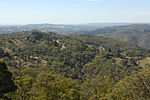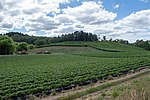Marble Hill, South Australia

Marble Hill was the Vice-Regal summer residence for the Governor of South Australia for seventy-five years, from 1880 to 1955. It is also the name of a ward of the Adelaide Hills Council, and a suburb, both named after the residence and in which the residence is located. It is about 20 kilometres (12 mi) east of Adelaide between the towns of Ashton and Cherryville, and has expansive views of the Adelaide Hills to the North and East, and the Adelaide Plains to the West.The residence was destroyed during the Black Sunday bushfire of 1955. Subsequently, the site was managed by the National Trust of South Australia from 1967 to 1992, and the Department for Environment and Heritage from 1992 to 2009. A volunteer Friends of Parks group, Friends of Marble Hill, ran open days and maintained the site from 1994 to 2008. To date, the main building has never been fully restored, but the National Trust undertook restoration of the tower and the nearby stables in the 1970s. Successive State Governments have not been prepared to restore the building (despite it having been a residence of the vice-regal representative), as the expense involved would not be considered responsible use of public funds. In 2009, Marble Hill was sold to a local family, who plan to reconstruct and re-use the building.
Excerpt from the Wikipedia article Marble Hill, South Australia (License: CC BY-SA 3.0, Authors, Images).Marble Hill, South Australia
17 Track, Adelaide Hills Council
Geographical coordinates (GPS) Address Nearby Places Show on map
Geographical coordinates (GPS)
| Latitude | Longitude |
|---|---|
| N -34.919388888889 ° | E 138.75841388889 ° |
Address
Marble Hill ruins
17 Track
5137 Adelaide Hills Council
South Australia, Australia
Open on Google Maps








